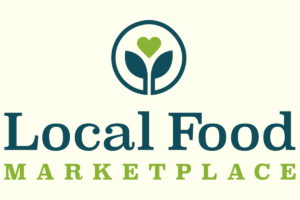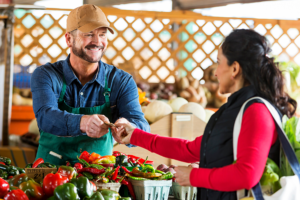
The Bloomington Community Farmers’ Market pre COVID-19. Photo courtesy of Rachel Beyer.
The Bloomington Community Farmers’ Market has been a central part of the city’s connection to local food for more than 45 years. Like many other markets around the country, they found themselves scrambling to safely open during the COVID-19 pandemic. Using the LFM software to set up an online store has been essential to their continued operation this year. We spoke to Rachel Beyer at the market to get the inside scoop.
LFM: Hi Rachel! Thanks for speaking with us. We’re really interested in what it’s been like for your market since the shutdown. How has that been?
Rachel: Market staff, vendors and customers have all had to pivot and be incredibly flexible during this time as we’ve experimented to maximize safety and deliver food in new ways. Overall, I have been really amazed to see how important local food is to people in our community.
LFM: Wow – what was your market using before LFM?
Rachel: Before the COVID-19 pandemic, the Bloomington Market had only ever operated as a traditional, in-person market with on-site sales. We knew we needed to use some kind of online ordering system to automate the process and compile the necessary data. I had heard about Local Food Marketplace in some research for a farm to institution project and when this whole situation came up, we reached out to Amy right away!
LFM: What was the transition like?
Rachel: We launched our first week with over 40 vendors. Everyone worked together, pushed through, and we made it happen, with a lot of wonderful support from the LFM team.
For the first month with the online store we also ran a drive-thru distribution. Vendors would upload what they had on a weekly basis, then drop off their products on Saturday mornings. Then we’d set-up a warehouse distribution system in a big building at one of our city parks and a group of staff, volunteers, and market vendors would go around with shopping carts to fill orders, pack them, and run them out to cars. It was challenging to do all this and keep the number of people working on site to a minimum. We had to cap customer orders each week to ensure that our small team could handle all of the drive-thru logistics.
In May, we decided to switch to a customer walk-through format with special safety protocols. As vendor and product counts continued to increase, we did not think the drive-thru was going to be a sustainable format to maintain. Now vendors upload their products to the online store at the beginning of each week. The store is open for shopping Tuesday-Thursday. Then on Saturdays vendors come to the regular, outdoor market location and set up their booths in alphabetical order with extra spacing to maximize social distancing. Table coverings are not allowed, so that table surfaces can be frequently disinfected throughout the day. Customers arrive according to time slots designated by last name. They receive a hard copy of their order form and are instructed how to walk through the market and pick up their orders with one-way traffic. We ask everyone to wear masks and gloves. Vendors are limited to 2 people per booth and customers are asked to send just one person per family to pick up. We limit the total number of customers in the large market area to 75 at one time. So far, this format has worked really well! We have capacity to accept a lot more customers than in the drive thru model!
LFM: As the state reopens, do you have plans for adding to your online sales?
Rachel: As the state economy slowly reopens, we are looking at adding onsite purchases alongside LFM online pre-orders.
I do want to say that our market would not have been able to open without LFM this spring. The online platform has made a huge difference for a lot of small businesses in our community that rely on our farmers market as an essential part of their income. Our market staff, vendors, and the broader community want all of you to know how grateful we are. You guys are a great team!



